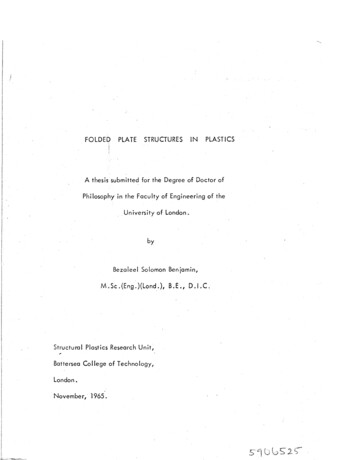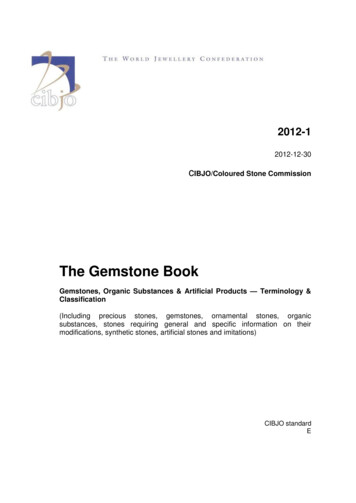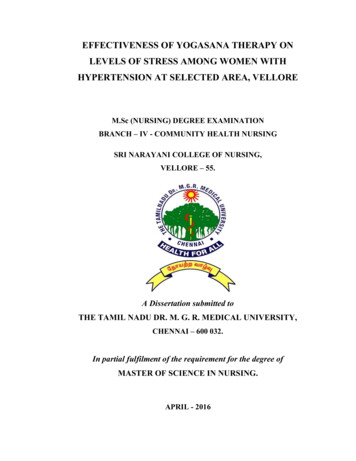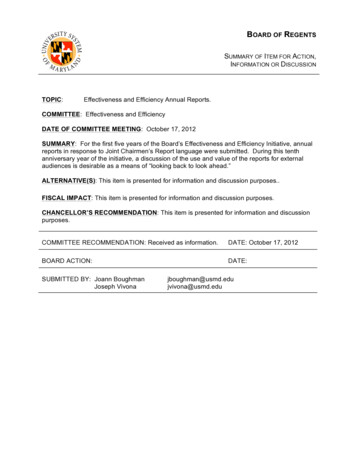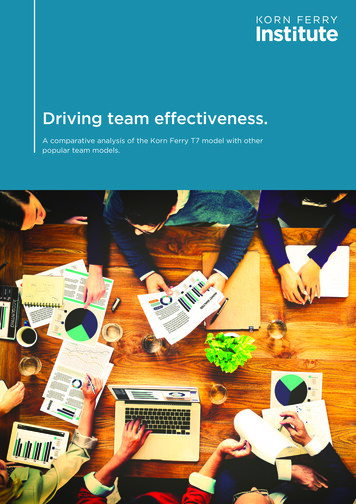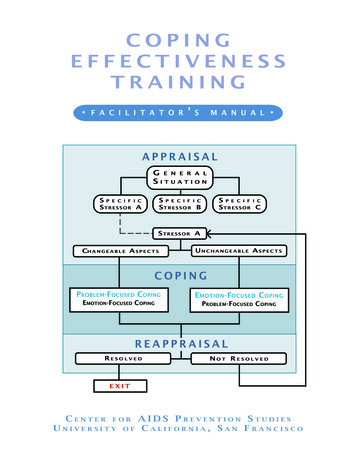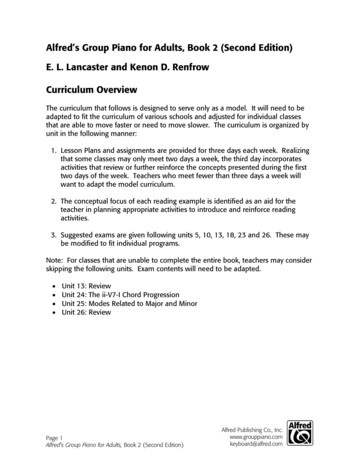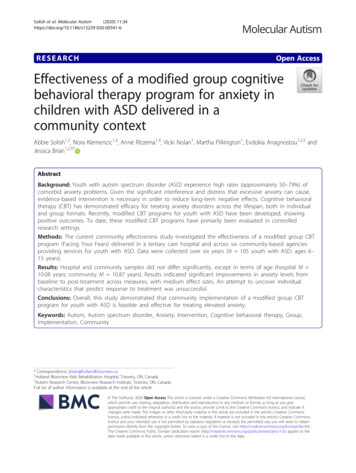
Transcription
Solish et al. Molecular Autism(2020) EARCHOpen AccessEffectiveness of a modified group cognitivebehavioral therapy program for anxiety inchildren with ASD delivered in acommunity contextAbbie Solish1,2, Nora Klemencic1,3, Anne Ritzema1,4, Vicki Nolan1, Martha Pilkington1, Evdokia Anagnostou1,2,5 andJessica Brian1,2,5*AbstractBackground: Youth with autism spectrum disorder (ASD) experience high rates (approximately 50–79%) ofcomorbid anxiety problems. Given the significant interference and distress that excessive anxiety can cause,evidence-based intervention is necessary in order to reduce long-term negative effects. Cognitive behavioraltherapy (CBT) has demonstrated efficacy for treating anxiety disorders across the lifespan, both in individualand group formats. Recently, modified CBT programs for youth with ASD have been developed, showingpositive outcomes. To date, these modified CBT programs have primarily been evaluated in controlledresearch settings.Methods: The current community effectiveness study investigated the effectiveness of a modified group CBTprogram (Facing Your Fears) delivered in a tertiary care hospital and across six community-based agenciesproviding services for youth with ASD. Data were collected over six years (N 105 youth with ASD; ages 6–15 years).Results: Hospital and community samples did not differ significantly, except in terms of age (hospital M 10.08 years; community M 10.87 years). Results indicated significant improvements in anxiety levels frombaseline to post-treatment across measures, with medium effect sizes. An attempt to uncover individualcharacteristics that predict response to treatment was unsuccessful.Conclusions: Overall, this study demonstrated that community implementation of a modified group CBTprogram for youth with ASD is feasible and effective for treating elevated anxiety.Keywords: Autism, Autism spectrum disorder, Anxiety, Intervention, Cognitive behavioral therapy, Group,Implementation, Community* Correspondence: jbrian@hollandbloorview.ca1Holland Bloorview Kids Rehabilitation Hospital, Toronto, ON, Canada2Autism Research Centre, Bloorview Research Institute, Toronto, ON, CanadaFull list of author information is available at the end of the article The Author(s). 2020 Open Access This article is licensed under a Creative Commons Attribution 4.0 International License,which permits use, sharing, adaptation, distribution and reproduction in any medium or format, as long as you giveappropriate credit to the original author(s) and the source, provide a link to the Creative Commons licence, and indicate ifchanges were made. The images or other third party material in this article are included in the article's Creative Commonslicence, unless indicated otherwise in a credit line to the material. If material is not included in the article's Creative Commonslicence and your intended use is not permitted by statutory regulation or exceeds the permitted use, you will need to obtainpermission directly from the copyright holder. To view a copy of this licence, visit http://creativecommons.org/licenses/by/4.0/.The Creative Commons Public Domain Dedication waiver ) applies to thedata made available in this article, unless otherwise stated in a credit line to the data.
Solish et al. Molecular Autism(2020) 11:34Key points Youth with autism spectrum disorder (ASD)experience high rates of anxiety Modified cognitive behavioral therapy (CBT) programs for youth with ASD are efficacious basedon well controlled lab-based studiesWe examined the effectiveness of communityimplementation of a modified CBT program (FacingYour Fears) in a large sample of youth with ASD,aged 6 to 15 years by comparing results from atertiary hospital program versus communityprogram deliveryHospital and community-based program delivery resulted in comparable significant improvements inanxiety following treatmentAn attempt to uncover individual predictors oftreatment response was unsuccessfulFindings demonstrate that communityimplementation of a modified group CBT programfor youth with ASD is feasible and effective fortreating elevated anxietyIntroductionAutism spectrum disorder (ASD) is a complex neurodevelopmental disorder characterized by impairmentsin social interaction and communication, and thepresence of stereotyped, repetitive behavior, and/orrestricted interests [1]. Based on recent reports, ASDaffects as many as 1 in 59 children [2]. Children andyouth with ASD experience high levels of anxiety [3].A recent review of studies examining the prevalenceof anxiety disorders in ASD, based on InternationalStatistical Classification of Diseases (ICD), or Diagnostic and Statistical Manual of Mental Disorders(DSM) criteria, revealed high rates of comorbidity,with the majority reporting a prevalence of around50%, although some reported rates as high as 78–79%[4–6]. Excessive anxiety causes considerable distressand interference with daily functioning [7], andwithout intervention, may become more impairingwith age, thereby negatively impacting long-termprognosis and outcome [8]. Addressing anxiety is animportant treatment goal for children and youth withASD, in order to mitigate the long-term cycle ofmaladaptation.Studies examining the use of psychosocial interventions such as cognitive behavioral therapy (CBT) totreat anxiety in ASD have emerged over the past decade [9]. A small number of CBT programs have beendesigned or adapted specifically for children withASD, yielding improvements in anxiety symptoms inresponse to both group and individual formats [10–15]. An initial systematic review and meta-analysisPage 2 of 11[16], and a more recent review of randomized controltrials (RCTs) [17] converge to conclude that in general, psychosocial interventions are superior to waitlistcontrol or treatment as usual (TAU) conditions. Themajority of studies report significant reductions inanxiety symptoms in children receiving CBT, basedon self-, parent-, and/or clinician-report, or by children no longer fulfilling criteria for an anxiety disorder [10, 11], with one outlier [18] failing to find anadvantage for CBT when compared to a Social Recreational program. Taken together, there is evidencesupporting favorable reductions in anxiety for youthwith ASD and anxiety in response to CBT-based interventions, but evidence gaps remain. Notably, mostevidence comes from efficacy studies that rely heavilyon involvement from the program developers or oncarefully controlled research-based delivery—it remains to be demonstrated whether such programs arefeasible and effective in wide-scale community implementation [19].Establishing the transportability of efficacious interventions into community settings is a necessary stepin increasing access. Despite the growing body of evidence for the efficacy of CBT for youth with ASD,there remains a gap between research-based and community implementation of these interventions [20].Recently, program developers demonstrated the initialportability of the Facing Your Fears program inpartnership with an outpatient service at a PediatricHospital in Nova Scotia, Canada (n 16) [21]. Overhalf of group participants saw meaningful reductionsin anxiety thus demonstrating, in a small sample, thepromise of community implementation. Evaluation ofeffectiveness through a large-scale community trial remains to be conducted and is the necessary next stepin establishing an evidence base for such programsthat can inform practice and policy.Questions also remain about individual differencesin treatment response, with possible influences ofanxiety and ASD symptoms, cognitive functioning, orlanguage ability. Some evidence points to higher anxiety in children with milder ASD symptoms [22–24](but findings are inconsistent [25, 26]), or in thosewho are cognitively higher functioning [22, 27] (alsowith mixed findings [3, 28]). The role of age is alsounclear, with older children experiencing higher anxiety in some studies [29, 30], but not others [27, 31].The impact of these individual differences on treatment response may inform future research, programming, or policy decisions.The current community effectiveness study examinedthe effectiveness of a manualized group CBT program(Facing Your Fears; FYF [32]) by examining outcomesfor participants receiving treatment in a tertiary hospital
Solish et al. Molecular Autism(2020) 11:34Page 3 of 11and community-based ASD service settings. This studyaimed to answer three questions:1) Is modified group CBT for children and youth withASD effective when implemented as a clinicalservice?2) Is the FYF program less effective in communityimplementation than when delivered in aspecialized hospital setting?3) Do individual child characteristics significantlypredict treatment response?MethodParticipantsOne hundred and seventeen children/youth aged 6.91 to15.33 years enrolled in a 14-week CBT clinical intervention adapted for individuals with ASD (FYF [32]) either ina specialized hospital setting (main site) or through one ofsix community-based agencies providing services foryouth with ASD (community sites). Eligibility required anASD diagnosis, broadly average intellectual ability, elevated levels of anxiety, and no significant behavioral disturbances that preclude group participation. Of the 117children enrolled, 12 did not complete group due to disruptive behavior/ not being able to manage the group context (n 6), missing 3 sessions (n 5), or change infamily availability (n 1). A total of 105 children were included in the analyses (76 males, 29 females; see Table 1for sample characteristics). This study received approvalTable 1 Participant baseline characteristicsVariablenMean (SD)RangeAge (years)10510.47 (1.75)6.91–15.33IQ74103.70 (14.54)69–135SRS Total T-score10474.90 (9.79)49–90SCQ Total score10516.52 (5.94)2–30Parent-report SCAS10434.88 (13.29)10–90Child-report SCAS10429.76 (13.52)4–71Parent-report SCARED10232.81 (11.41)6–72Child-report SCARED9924.57 (12.21)0–67Externalizing10358.62 (11.46)40–102Internalizing10265.34 (12.69)38–105Behavioral Symptoms Index (BSI)10270.32 (10.15)52–107ASD symptomsAnxiety (total scores)Behavior (BASC-2)Note. IQ Full-Scale IQ (FSIQ) or Generalized Ability Index (GAI) from WASI,WASI-II, WISC-IV, WISC-V, WPPSI-III, or Stanford-Binet Intelligence Scales, FifthEdition (SB5). SRS Social Responsiveness Scale, First and Second Editions, SCQSocial Communication Questionnaire, SCAS Spence Children’s Anxiety Scale(Total Score), SCARED Screen for Child Anxiety Related Emotional Disorders(Total Score), BASC-2 Behavior Assessment System for Children, Second Edition(T scores)as a retrospective chart review by the research ethicsboard at the main hospital.All children had a diagnosis of ASD (DSM-5 or DSMIV Autism, Asperger Syndrome, or Pervasive Developmental Disorder, Not Otherwise Specified) made by aphysician or psychologist prior to enrollment in the program. Average intellectual functioning (full scale IQ 80)was confirmed for most participants (n 64) duringscreening or based on formal reports (if within two yearsof group). A small number (n 4) had below-average intellectual functioning, due to enrollment prior to assessment. Anxiety symptoms were assessed through semistructured telephone interviews with parents, and parentand child-reported questionnaires. Comorbid difficulties(e.g., depressed mood, attention-deficit/hyperactivity disorder, learning disability) did not exclude children whowere considered likely to be able to manage the groupcontext.ProcedureEligibility screening was conducted, within 2 monthsprior to group participation, by registered clinicaldoctoral-level psychologists (or those in the process ofregistering), or pre-doctoral-level psychology interns. Astructured telephone interview (45–60 min) covered previous assessments and diagnoses, educational history,prior experience in group settings, and detailed information about past and current mood and anxiety symptomsand management (formal diagnoses, specific fears, phobias, avoided situations, medications, previous interventions). Next, parents and children attended individual inperson screenings for cognitive assessment and childand parent-baseline questionnaires. Additional preintervention data were collected during the first treatment session (measures described below).The group intervention was run according to the Facing Your Fears Facilitator’s Manual [32]. Groups at themain site were run primarily by psychologists and psychology interns who had participated in training workshops by the program developers (Judy Reaven [JR] andAudrey Blakeley-Smith [ABS]) and/or who had undergone video-based fidelity monitoring with JR. To attainfidelity, sessions were video-taped and sent to programdeveloper, JR. She watched them and scored them basedon her fidelity checklist developed for the FYF program.Following her review of every 2–3 sessions, the teammet with JR over the telephone to discuss their use ofintervention procedures. All staff at the main siteattained 80% fidelity in implementing the program foreach session. Every time a new community partner wasadded, the same fidelity process was repeated, and allcommunity sites received 80% fidelity on their firstgroup delivery; the last community site was added inyear 5 of the 6-year project, allowing for fidelity checks
Solish et al. Molecular Autism(2020) 11:34throughout much of the length of the project. All groupsat the main and community sites were run with at leastone clinician who had already achieved 80% fidelity. Intotal, seven psychologists and nine psychology interns atthe main site were trained; group leaders also includedthree social workers, two psychology practicum students,one developmental pediatrician, and one behavior therapist, all of whom were trained by lead psychologists orprogram developers. Community sites sent at least onestaff member to the main site to co-lead FYF prior to facilitating groups at their own agencies. Group leadersacross six community sites included 28 behavior therapists, 7 social workers, 2 psychologists, 1 psychologyintern, 1 practicum student, 2 family counsellors, and 1early childhood educator. In all but one case, one mainsite lead psychologist co-led each group in the community. Ongoing consultation phone calls with JR tookplace after fidelity monitoring was complete, allowinggroup leaders to consult regularly with an expert whilerunning the groups.Twenty-six groups (12 main sites; 14 community) of 3to 5 child/parent dyads each, took place over a six-yearperiod. Groups involved 14 weekly 1.5-h sessions (12–13sessions for four community groups due to staffing constraints). Per FYF protocol, initial sessions focused onemotion regulation (e.g., identifying emotions, gainingawareness of anxiety-related physical symptoms andthought patterns, practicing relaxation, using “helpfulthoughts”), while later sessions focused on hierarchicalexposure practice (i.e., facing fears). Child participantsand at least one parent spent time working together andapart in separate parent and child groups. Weekly homepractice was assigned and reinforcement strategies wereused to encourage exposure practice between sessions.MeasuresWechsler Abbreviated Scale of Intelligence (WASI andWASI-II) [33, 34]. The WASI or WASI-II was used atbaseline to estimate full-scale IQ using two verbal subscales and two nonverbal subscales. Both editions of theWASI demonstrate good internal consistency (split-halfreliability coefficients .80 within child sample for allsubtests), good test-retest stability, and good internalvalidity. The WASI and WASI-II are highly correlated (rrange .71 to .88 across subtests).Social Responsiveness Scale (SRS and SRS-2) [35, 36].The SRS or SRS-2 was used at baseline to characterizeparticipants’ ASD symptoms. This 65-item caregiverreport questionnaire for children aged 4–18 consists offive sub-scales: Social Awareness, Social Cognition, Social Communication, Social Motivation, and AutisticMannerisms; and a Total T score. Items are rated from0 (“not true”) to 3 (“always true”), with T-scores 60within the clinical range. The SRS and SRS-2 have well-Page 4 of 11documented reliability (e.g., strong internal consistency,α typically .90) and validity. We used both versions because version 2 was released while data collection wasongoing; the SRS and SRS-2 have identical content [36].Social Communication Questionnaire (SCQ) [37]. TheSCQ, also used at baseline, is a 40-item parentcompleted questionnaire based on the Autism Diagnostic Interview -Revised (ADI-R) [38]. The SCQ has goodinternal consistency (α ranging from .84 to .93), and validity (i.e., most items discriminate between ASD andnon-ASD).Spence Children’s Anxiety Scale, Child and Parent versions (SCAS) [39]. The SCAS was used at screening andpost-intervention. This measure of anxious symptoms(44 items on the child self-report, and 38 items on theparent-report) has good full-scale internal consistency (α .90) and acceptable test-retest reliability after a 6month delay (r .60) [39]. Internal consistency estimates for the current sample ranged from .85 to .90.Screen for Child Anxiety Related Emotional Disorders,Child and Parent versions (SCARED) [40]. The SCAREDis a 38-item measure of anxious symptoms, with bothchild and parent versions (both used pre- and postintervention). The SCARED has strong full-scale internalconsistency (α .93), good test-retest reliability (r .86),and good discriminant validity in a child clinical sample[40]. Internal consistency estimates for the current sample ranged from .86 to .92.Behavior Assessment System for Children, Second Edition (BASC-2) [41]. The BASC-2 Parent Rating Scaleswere used in the current study, both pre- and postintervention; this includes 150 (adolescent) or 160(child) behavioral items rated based on frequency (neverto almost always). Three age-based standardized composite scores were used: externalizing problems (e.g., ernalizing problems (e.g., mood and anxiety difficulties, stress-related physical symptoms), and behavioralsymptoms Index (BSI; e.g., atypical behavior, social concerns, and attentional problems). The BASC-2 has goodinternal consistency for individual ( .80) and composite( .90) scales, and good test-retest reliability for individual (70-80%) and composite ( 80%) scales, across agegroups.Group Questionnaires, Parent and Child versions. Developed by authors (AS and JB) to be used pre- and postintervention. Includes quantitative ratings (e.g., levels ofanxiety and its interference), and qualitative responses(e.g., strategies a parent is currently using). Item development was informed by knowledge of anxiety and ASD andon parenting children with ASD. See Appendix A for detailed description of items and domains used in analyses.Satisfaction Questionnaire. Parents’ satisfaction withthe program was measured following intervention. The
(2020) 11:34Solish et al. Molecular AutismPage 5 of 11Table 2 ANOVAs comparing groups on baseline characteristicsVariableMain site mean (SD)Community sites mean (SD)F (df)pGender74.1% male70.6 % male.16 (1, 103).69Age10.08 (1.71)10.87 (1.72)5.60 (1, 103).02IQ102.68 (15.00)104.78 (14.17).38 (1, 72).54SRS (total t score)73.79 (10.36)76.06 (9.12)1.40 (1, 102).24SCQ (total score)16.77 (6.08)16.26 (5.83).19 (1, 103).67Note. SRS Social Responsiveness Scale, First and Second Editions, SCQ Social Communication Questionnairequestionnaire includes four qualitative responses (e.g.,what parents liked most and least about the program)and 18 quantitative ratings (e.g., quality of the program,amount and type of help received, efficacy, quality of instruction) rated on a 1-9 scale, thus yielding a score outof 162.ResultsBaseline group comparisonsOne-way ANOVAs compared baseline characteristics ofparticipants at the main site (n 51) and communitybased settings (community; n 54). Groups differedonly by age (Table 2). ANCOVA, controlling for age,showed no significant differences between groups onpre-treatment measures of anxiety or other behavioraldifficulties (Table 3).Treatment effectsCombined samplePaired samples t tests revealed significant improvementsfrom pre- to post-treatment on 11 (of 13 tested) measures of anxiety and behavior (see Table 4). Family-wiseerror corrections were made for analyses that used measures with multiple domains; specifically, adjusted p’s .02 (BASC-2), .01 (Parent Questionnaire), and .03 (ChildQuestionnaire). All other tests (i.e., SCAS and SCARED)used critical p .05.Within-site effectst tests for the main and community sites separatelyyielded the same significant intervention effects (as combined) with the exception of one: Child-reported anxiety(SCAS) did not change significantly in the communitygroup (t (49) 1.62, p .11; pre-treatment M 30.76,Table 3 Baseline behavioral measures across groupsMain site mean (SD)aCommunity sites mean (SD)aF (df)bpSCARED31.89 (9.96)33.84 (12.88).49 (1,99).48SCAS34.47 (13.01)35.32 (13.69).42 (1,101).52Externalizing57.55 (11.74)59.76 (11.15)1.76 (1, 100).19Internalizing64.11 (11.40)66.67 (13.95).83 (1,99).37BSI69.85 (11.51)70.84 (8.51).50 (1,99).48Effective3.45 (1.20)3.72 (1.18)1.06 (1, 97).31Avoidance2.70 (1.33)2.82 (1.17).07 (1,95).80Interference5.00 (1.50)5.27 (1.41).78 (1,97).38Family impact5.17 (1.84)5.28 (1.79).01 (1, 97).92SCARED23.10 (11.21)26.20 (13.15)1.12 (1,96).29SCAS28.96 (12.18)30.59 (14.86).51 (1,101).48Amount of worry3.34 (2.04)3.83 (2.07).83 (1, 96).37Interference/distress3.22 (2.48)3.88 (2.40)1.40 (1,96).24MeasuresParent reportBASC-2 (t scores)Parent questionnaireChild reportChild questionnaireNote. SCARED Screen for Child Anxiety Related Emotional Disorders, total score, SCAS Spence Children’s Anxiety Scale, total score, BASC-2 Behavior AssessmentSystem for Children, Second Edition; see Appendix A for information on Parent and Child QuestionnairesaUnadjusted means reportedbAdjusted F-statistic from ANCOVA controlling for age
Solish et al. Molecular Autism(2020) 11:34Page 6 of 11Table 4 Pre- and post-treatment performance on behavioral measures (combined sample)Pre-treatment mean (SD)Post-treatment mean (SD)T (df)PaEffect sizebSCARED33.28 (11.21)26.00 (10.45)8.00 (97) .001.67SCAS35.23 (13.35)28.68 (11.71)6.10 (99) .001.52Externalizing59.13 (12.04)56.19 (11.01)3.98 (85) .001.24Internalizing65.36 (12.23)59.26 (11.63)6.20 (87) .001.51BSI70.31 (10.19)66.13 (10.03)5.98 (87) .001.41MeasuresParent reportBASC-2 (T scores)Parent questionnaireEffective3.59 (1.19)5.02 (1.33)-8.82 (92) .001 1.14Avoidance2.79 (1.24)2.20 (1.20)3.98 (89) .001.48Interference5.13 (1.46)4.28 (1.45)5.71 (92) .001.59Family impact5.27 (1.81)4.28 (1.91)4.66 (92) .001.53SCARED24.84 (12.18)20.17 (13.35)4.42 (96) .001.36SCAS29.83 (13.56)24.52 (15.17)3.77 (102) .001.37Amount of worry3.60 (2.06)3.49 (1.89).55 (97).58.05Interference/distress3.56 (2.45)3.29 (2.13)1.19 (97).24.12Child reportChild questionnaireNote. SCARED Screen for Child Anxiety Related Emotional Disorders, total score, SCAS Spence Children’s Anxiety Scale, total score, BASC-2 Behavior AssessmentSystem for Children, Second EditionaSignificance based on corrected p valuesbEffect size used modified Cohen’s D to correct for correlation between dependent variables [d t(2(1-r)/n)1/2] [48]SD 14.96; post-treatment M 26.92, SD 17.29),whereas it did for the main site (t (52) 4.23, p .001;pre-treatment M 28.96, SD 12.18; post-treatment M 22.25, SD 12.61).Cross-site comparisonsChange scores were calculated for the 11 variables identified as changing significantly over time. Negativechange scores represent improvement in symptoms except for the Parent Questionnaire variable “effective”(Table 5). One-way ANCOVAS, controlling for age, revealed no group differences in any of the change scores,and negligible effect sizes.Predictors of treatment responseData were combined across sites (N 105) to examinecorrelations between anxiety change scores and four participant baseline characteristics (age, Full-Scale IQ, TotalASD symptoms on SRS and SCQ). Using Pearson’s bivariate correlations, only one correlation reached significance, with parent-rated improvement in anxiety(SCARED) being negatively correlated with child’s IQ, r .32, p .008. Four separate one-way ANOVAs, withgender as the grouping variable, revealed no differenceswith respect to change scores on any of the pre-postanxiety measures (all p’s .25).Change scores for the main anxiety measures (SCASand SCARED, parent- and child-report) were also examined as dependent variables in four linear regressionmodels using the five participant characteristics as predictors with critical p set to .01 (.05/4). No modelsreached statistical significance. IQ approached significance as a negative predictor of the change in parentreport SCARED score, β .29, p .022.Retention and parent satisfactionOut of a total 117 children enrolled, 12 were unable tocomplete the intervention protocol with fewer than 3missed sessions, yielding a retention rate of 89.74%.Parent-rated satisfaction was high, with a mean of140.62 (SD 15.43) out of a possible 162. Correlationsrevealed a general pattern of positive associations between satisfaction and improvements in anxiety symptoms, with moderately strong correlations betweenparent-reported anxiety (on the SCAS) and the following: How (improved) is your child’s anxiety at this pointas compared to the start of the group? (r .34, p .001; the only association to retain significance whenusing family-wise error correction (p .0027); The content of information presented was (how helpful)? (r .30, p .003); in-session exposures with your child during group sessions were (how helpful)? (r .30, p
Solish et al. Molecular Autism(2020) 11:34Page 7 of 11Table 5 Change scores for combined sample and for main and community samples separatelyVariableChange score mean (SD)Combined sampleChange score mean (SD)Main siteChange score mean (SD)Community sitespaEffect sizebParent reportSCARED 7.28 (9.01) 7.14 (8.00) 7.43 (10.08).79.001SCAS 6.54 (10.72) 6.30 (9.46) 6.79 (11.99).66.002 2.94 (6.86) 2.98 (7.04) 2.90 (6.74).83.001BASC-2 (T scores)ExternalizingInternalizing 6.10 (9.23) 6.09 (8.40) 6.11 (10.14).82.001BSI 4.18 (6.56) 4.47 (7.11) 3.88 (5.99).84 .001Effective1.43 (1.57) 1.61 (1.49) 1.23 (1.64).39.008Avoidance .59 (1.40).55 (1.37).63 (1.46).80.001Interference .85 (1.44).83 (1.53).88 (1.35).83 .001Family impact .98 (2.04)1.13 (2.30).82 (1.70).41.008Parent questionnaireChild reportSCARED 4.67 (10.42) 6.13 (12.08) 3.06 (8.03).15.022SCAS 5.31 (14.30) 6.70 (11.53) 3.84 (16.75).29.011Note. SCARED Screen for Child Anxiety Related Emotional Disorders, total score, SCAS Spence Children’s Anxiety Scale, total score, BASC-2 Behavior AssessmentSystem for Children, Second EditionaSignificance based on between-site ANCOVA (controlling for age)bEffect size is Cohen’s D.004); and how confident do you feel managing yourchild’s feelings of anxiety now? (r .29, p .005).DiscussionAs hypothesized, youth with ASD and anxiety experienced an overall reduction in anxiety symptoms following a group CBT program tailored to this population.Improvements were similar across hospital and community settings, and retention and parent satisfaction werehigh. These findings demonstrate the feasibility, acceptability, and effectiveness of the FYF program when implemented in community settings with adequate upfront training and ongoing support.Parent-reported improvements in anxious symptomsyielded mainly medium-sized effects, in line with previous studies in well-controlled settings [10–12, 42], withreported reductions in anxiety symptoms very similar tothose previously reported using the same measure(SCARED) [11]. Interestingly, the magnitude of changein total scores was almost identical for the two instruments used in the current study, and the effect sizeswere comparable. As such, we are not able to recommend one instrument over the other for future applications. Our smaller effects on externalizing difficulties arenot surprising, given that disruptive behavior was not adirect intervention target. Moreover, youth were excluded if they displayed significant disruptive behaviors,leaving less room for reduction (i.e., a possible floor effect). Indeed, mean externalizing behavior ratings didnot reach clinically significant levels before or after treatment. In contrast, mean internalizing behavior ratings(which include anxious behavior) dropped from above tobelow the clinical cut-off on the BASC-2.A large effect was seen for parents’ report of their ownincreased levels of confidence and perceived effectiveness in parenting their anxious children. This likely reflects parents’ high levels of involvement in theintervention, which includes specific training and practice with management of children’s anxious symptoms.Parents’ experienced gains have the potential for longterm impact.Children’s self-reported changes in anxiety symptomsyielded smaller effects than parents’ reports, with onlysome measures indicating small to medium effects(SCAS, SCARED). Positive effects emerged from wellestablished measures which were likely psychometricallystronger than the questionnaire developed for this study,which detected no change. Determining which (if any)self-report measures are valid for accessing emotionalstates of youth with ASD and anxiety has been a longstanding concern in this field [12, 14]. In some studies,parent and child SCAS anxiety ratings improve in concert [10] or are highly correlated (e.g., r .66 at baseline)[42], suggesting that children/youth with ASD do havereliable awareness of their own anxiety symptoms. Incontrast, however, Sofronoff and colleagues [12] foundthat children did not pro
tions such as cognitive behavioral therapy (CBT) to treat anxiety in ASD have emerged over the past dec-ade [9]. A small number of CBT programs have been designed or adapted specifically for children with ASD, yielding improvements in anxiety symptoms i


